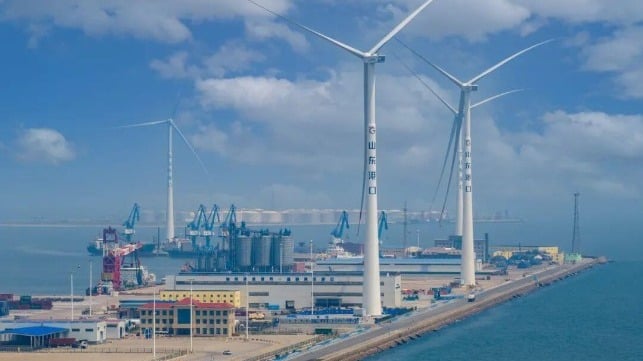|

Weifang Port has become the first port in China to officially achieve carbon neutrality, amid a huge push to decarbonize the global shipping industry.
On 15 October, the port in Shandong was certified as carbon-neutral by the China Classification Society Quality Certification Company, according to a government statement.
Weifang Port’s “zero-carbon” certification was primarily achieved by transitioning away from fossil fuel use, according to China Electric Power News (CEPN). It has built a wind power system to provide green energy for its operations and deployed hydrogen-powered vehicles to replace fossil-fuel powered trucks. For “unavoidable emissions”, which were not specified in the announcement, Weifang Port purchases certified carbon credits to ensure the port remains “zero-carbon” even during peak operational periods, according to CEPN.
Globally, the shipping industry accounts for 3% of greenhouse gas emissions, with ports being one of the key contributors along with ships running on heavy fuel oil. According to reports from Yicai, a major financial news outlet, the construction of “zero-carbon ports” is becoming a hot topic in China’s transportation sector. This month Tianjin Port announced the establishment of the world’s first “smart zero-carbon” terminal, Huangshi New Port successfully integrated a zero-carbon power plant into its operations, and Huanghua Port launched China’s first zero-carbon pilot project for a coal terminal. But Weifang is the first to achieve zero-carbon status for an entire port.
Despite this progress, decarbonising shipping faces many challenges. As port throughput continues to grow, energy consumption is also on the rise, and some ports are struggling with the technology and policy involved, leading to slow progress in achieving zero-carbon goals.
Wang Nini, a researcher at the Water Transport Science Research Institute of China’s Ministry of Transport, told Yicai that ports’ regionally centralised management provides favourable conditions for carbon reduction efforts compared to the harder to control compared to by-land transport. But there are still issues such as inefficient spatial planning and shoreline utilisation that does not consider clean energy deployment. Additionally, connecting ports to rail networks – which are a lower-emission form of transport than trucks – is problematic at many sites.
Although ports are gradually increasing their use of clean energy, such as wind and solar, many are restricted by site conditions and prevented from large-scale deployment of these sources. Some lack sufficient space or have outdated existing equipment that prevents the effective installation of solar power. In addition, carbon reduction standards and monitoring systems at ports need further improvement, as the absence of unified regulations presents challenges to advancing the zero-carbon transition, experts told Yicai.
https://maritime-executive.com/editorials/port-of-weifang-becomes-china-s-first-carbon-neutral-seaport
|